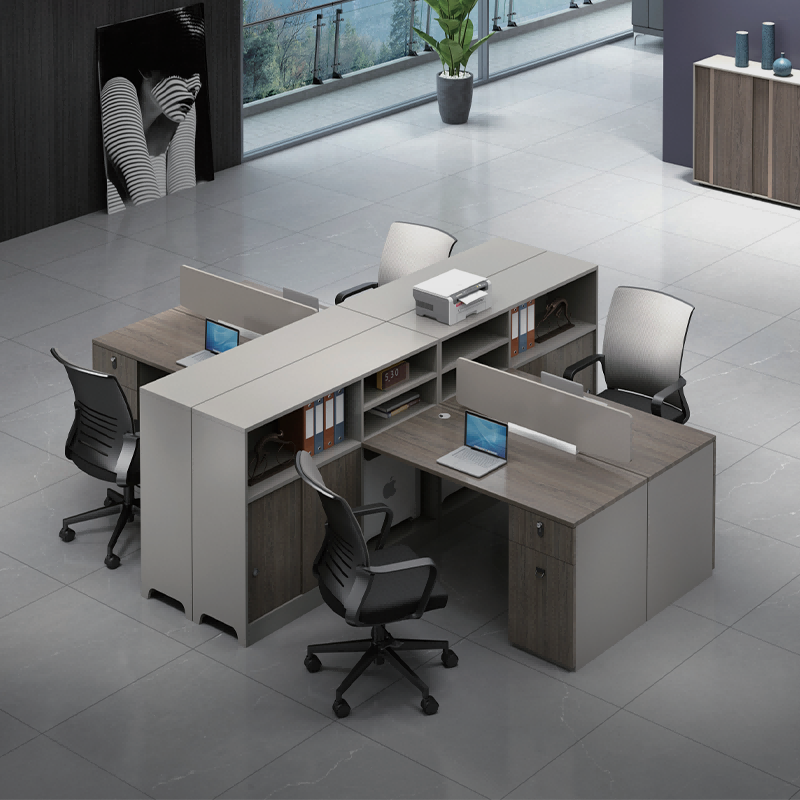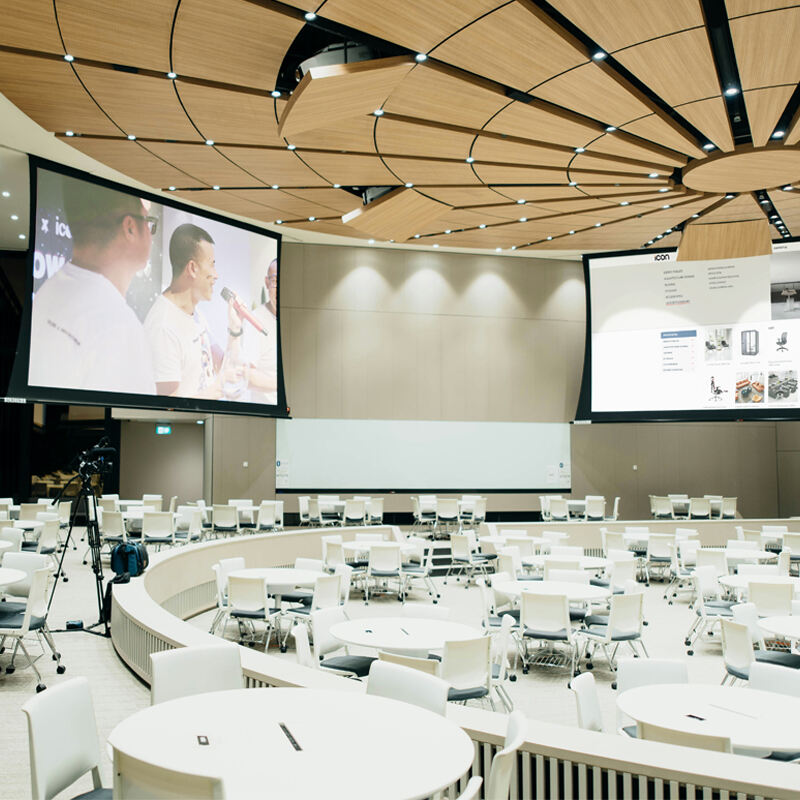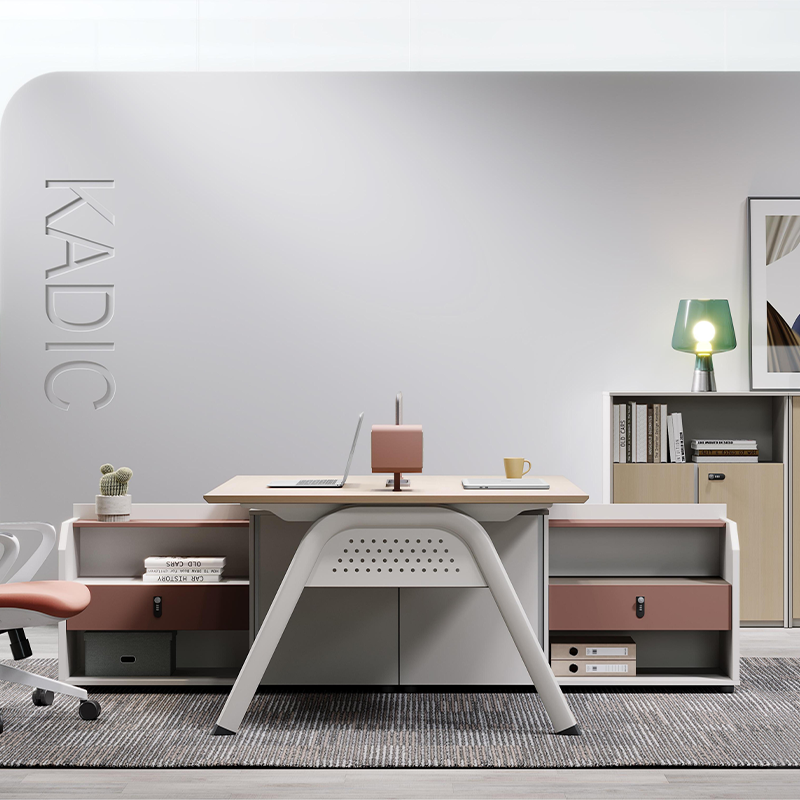Employee wellbeing has become a cornerstone in modern workplace strategies as businesses recognize its impact on productivity and job satisfaction. The design and quality of OFFICE FURNITURE are closely linked to employee health, happiness, and efficiency. With employees spending significant hours at their desks, the role of ergonomic office solutions cannot be overstated. This growing trend towards ergonomic furniture signifies a shift in business practices, emphasizing the need for supportive environments that reduce physical strain and prevent injuries. Companies investing in ergonomic designs like custom office desks and chairs are not only enhancing comfort but also fostering a culture of wellbeing, ultimately driving better business outcomes.
Ergonomic Design's Impact on Physical Health
Custom Standing Desks for Posture Support
Custom standing desks are pivotal in enhancing workplace ergonomics by promoting better posture and reducing the occurrence of back pain. These desks can be adjusted to suit individual height requirements, aligning with recommendations from health organizations like OSHA, which advises maintaining proper desk height to prevent postural issues. Musculoskeletal disorders, prevalent among office workers, affect millions globally, largely due to prolonged sitting and poor workstation setups. Adopting standing desks can mitigate these risks, offering a healthier alternative that boosts energy and productivity.
Preventing Repetitive Strain Injuries
In the fast-paced office environment, repetitive strain injuries (RSIs) are common and can significantly impact employee wellbeing and productivity. Factors such as poor posture, prolonged computer use without breaks, and inadequate office setups contribute to RSIs. To combat these issues, ergonomic features like keyboard trays that position hands at a natural angle and mice that fit comfortably in the palm can be integrated into office furniture sets. Research shows that implementing ergonomic interventions can reduce injury rates dramatically, emphasizing the importance of ergonomic designs in creating a sustainable work environment.
Adjustable Chairs for All-Day Comfort
Adjustable chairs are essential for ensuring comfort and productivity throughout the workday, accommodating various body types and reducing discomfort. These chairs allow users to modify seat height, backrest angle, and armrest positions, enabling a personalized fit that supports healthy postures. Testimonials from employees often highlight the enhanced comfort and focus provided by ergonomic chairs, which translate into improved productivity. Studies confirm that proper chair adjustability can lead to significant increases in employee satisfaction and task efficiency, reinforcing the value of investing in quality office furniture like custom office desks and chairs.
Mental Health Benefits of Thoughtful Furniture
Office Sofa Furniture in Relaxation Zones
Creating relaxation zones with office sofa furniture has proven effective in reducing stress levels among employees. Comfortable seating arrangements can act as stress relievers, providing a tranquil space to unwind during breaks. For instance, many companies, including Welsh furniture manufacturer Orangebox, have successfully implemented such areas to foster a sense of calm in the workplace. Psychological studies, such as those referenced in the Journal of Occupational Health Psychology, highlight the link between comfortable seating and reduced anxiety, emphasizing the importance of thoughtfully designed furniture in enhancing workplace well-being.
Meeting Pods for Stress-Free Collaboration
Meeting pods have emerged as a valuable addition to office environments, offering a stress-free setting for team discussions. These pods are designed to enhance collaboration by minimizing external distractions and providing a conducive space for focused dialogue. CASE studies, like those conducted by Kansas City Office Design, have shown improved collaborative outcomes in environments equipped with meeting pods. Research published in the Journal of Experimental Psychology reveals that isolated environments can enhance focus and creativity, highlighting the benefits of integrating meeting pods into office design.
Biophilic Elements in Workspace Design
Biophilic design principles incorporate nature-inspired elements into office furniture, benefiting mental health. Studies have shown that adding natural elements like plants, water features, or nature-themed designs can lead to improved employee satisfaction and well-being. For example, a study published in the Journal of Environmental Psychology demonstrated the positive impact of biophilic design on reducing stress levels and increasing productivity. Statistics indicate that incorporating biophilic elements can increase employee satisfaction by up to 15%, making it a valuable consideration in custom office desk design.
Productivity Enhancement Through Functional Layouts
Organized Office Furniture Sets for Efficiency
Organized office furniture sets play a vital role in boosting workflow and efficiency within workspaces. Strategic furniture arrangements eliminate clutter and enable streamlined movement between tasks, which can lead to significant productivity improvements. Studies indicate productivity gains of up to 20% in environments with well-articulated furniture layouts, showcasing the powerful impact of strategic interior design on performance. Experts emphasize the importance of creating spaces that facilitate easy access to necessary tools and resources, fostering an environment conducive to sustained focus and efficiency. By thoughtfully choosing and arranging office furniture, businesses can optimize their workforce's productivity effectively.
Smart Storage Solutions and Workflow
Implementing smart storage solutions is essential for reducing clutter, thereby enhancing focus and improving workflow. Key examples of effective storage designs include modular shelving, mobile storage units, and concealed compartments within desks, all contributing to maintaining tidiness. Evidence from productivity studies highlights a clear correlation between organized workspaces and improved performance, indicating that clutter-free environments can enhance mental clarity and reduce daily stress. By incorporating modern storage solutions, organizations can create workspaces that not only look professional but also boost the productivity of their employees.
Lighting Integration in Modern Desks
Proper lighting integrated into modern desks significantly influences employee productivity and mood. The blend of natural and artificial lighting can create an optimal ambiance that enhances focus and reduces eye strain, thereby promoting better health outcomes. Research demonstrates that natural lighting positively correlates with enhanced mood and cognitive function, while artificial lighting can be strategically arranged to complement natural light sources. Recommendations for optimal lighting conditions suggest positioning desks near windows and using adjustable lamp features for tailored illumination based on workspace usage. This thoughtful integration of lighting into desk design ensures a productive and health-oriented environment for employees.
Collaborative Spaces That Boost Team Wellbeing
Modular Furniture for Dynamic Meetings
The flexibility offered by modular furniture revolutionizes how meetings are conducted, creating spaces that adapt to various team needs. Modular furniture, such as reconfigurable tables and chairs, allows teams to efficiently organize their space to facilitate discussions, presentations, or group activities, providing the ideal environment for collaboration. According to work design insights, businesses that adopt flexible meeting spaces report increased collaboration and communication among their teams. Expert opinions suggest that the physical layout of a space significantly influences team dynamics, enhancing the effectiveness of group interactions and fostering innovative thinking. Such dynamic setups enable businesses to tailor their environments to specific objectives, promoting an agile and responsive team culture.
Office Sofas in Informal Idea Exchange
Office sofas play an essential role in encouraging informal discussions and brainstorming sessions, offering a relaxed atmosphere conducive to creativity. Numerous companies leverage these informal seating areas to foster a culture of open communication and idea-sharing. For example, tech giants like Google incorporate comfortable seating throughout their offices, recognizing its value in sparking spontaneous collaboration and innovation. Research also indicates that workplace configurations that facilitate social interactions lead to improved creativity and problem-solving skills. These findings highlight the importance of office sofa furniture in creating a work environment that values and promotes team interaction and collective brainstorming.
Custom Office Desks for Team Projects
Custom office desks are pivotal in enhancing collaborative efforts within teams by providing tailored solutions that meet specific project needs. These desks can be configured to support different team sizes and work styles, ensuring workspaces are optimized for team synergy. Testimonials from teams utilizing shared custom desks often cite improved communication and a seamless workflow, as shared desks eliminate barriers and encourage more interaction among members. Recent studies have shown that collaborative workspaces positively influence project outcomes, as they bring together diverse skills and perspectives, ultimately driving more successful and innovative projects. This underscores the importance of selecting the right design and configuration in custom office desks to boost team performance.
Color Psychology in Workplace Wellness
Strategic Color Choices for Focus Areas
The strategic use of color in office environments can significantly influence focus and productivity. Colors such as blue and green are often recommended for areas demanding concentration, as they are known to create a calming effect and enhance productivity. For instance, a study published in the Journal of Experimental Studies found that blue environments improved cognitive task performance. Companies like Facebook and Google have successfully utilized these color schemes to optimize employee output, implementing pastel blues and greens in their workspaces. Experts in design suggest incorporating these colors into office spaces with custom office desks to enhance concentration and efficiency, fostering a productive work environment.
Brand-Aligned Office Furniture Aesthetics
Aligning furniture aesthetics with a company's brand identity is crucial for boosting employee morale and enhancing brand perception. Office designs that reflect brand colors and motifs help in fostering a sense of belonging among employees. For example, companies such as Coca-Cola have enhanced their brand presence through their red-themed spaces, improving both engagement and pride among the workforce. Experts argue that maintaining congruence between brand identity and workspace design can lead to a more cohesive and inspired employee experience. This is especially facilitated by using cohesive office furniture sets that resonate with brand visuals, reinforcing the company ethos through daily engagement.
Balancing Visual Appeal with Function
Creating visually appealing yet functional office environments requires a strategic approach that balances aesthetics with practicality. Successful designs often marry style with functionality, ensuring that the workspace meets the practical needs of the employees without sacrificing beauty. Practical examples include innovative custom standing desks that offer ergonomic advantages while integrating stylish finishes. Experts recommend creating multi-functional spaces that leverage smart design without compromising usability. For instance, avoiding excessive clutter while choosing versatile furniture pieces can lead to productive environments, as evidenced in workspaces at tech firms like Apple and Microsoft.
By understanding these principles, businesses can craft office spaces that not only support wellness and productivity but also reflect brand values and foster creativity. Each aspect of workspace design—from color to furniture—plays a vital role in cultivating a thriving workplace atmosphere.
Future-Ready Solutions: Adaptive Furniture Trends
Convertible Standing Desk Systems
Convertible standing desk systems have emerged as a crucial element for promoting healthier work habits. These innovative desks encourage movement throughout the day, reducing the negative impact of prolonged sitting. Recent trends indicate a growing demand for these desks, both in corporate environments and HOME offices. Users have reported significant health improvements, including better posture and increased energy levels. For instance, a survey conducted at University Academy 92 found that 95% of participants experienced improved focus while using adjustable standing desks. These testimonials underscore the value of incorporating customizable furniture like convertible standing desk systems into modern workspaces.
Multi-Functional Office Furniture Sets
The trend toward multi-functional office furniture is rapidly gaining traction, driven by the need for space efficiency and versatile work environments. These furniture sets not only optimize space but also enhance the aesthetic appeal of the office. Examples include desks that double as storage units or meeting tables that seamlessly transition into collaborative stations. According to market studies, the demand for such space-saving designs has increased, with businesses seeking to maximize every square foot of their office space effectively. The popularity of multi-functional office furniture sets reflects a shift towards flexible and dynamic office layouts, accommodating both individual and team-based work.
Investing in Long-Term Wellbeing Design
Investing in designs that prioritize employee wellbeing is essential for long-term organizational success. Ergonomic office furniture, such as adjustable desks and supportive seating, plays a pivotal role in fostering a healthier workplace. Experts suggest that the return on investment (ROI) on such ergonomic designs far exceeds the initial costs, attributed to enhanced productivity and reduced health complaints. Organizations that prioritize wellbeing through thoughtful design often witness notable improvements in employee satisfaction and efficiency. The argument stands that spending on quality custom office desk solutions not only boosts morale but also creates a sustainable work environment where comfort meets functionality.
Conclusion
Summarizing the impact of office furniture on employee wellbeing highlights its pivotal role beyond mere aesthetics. Ergonomic designs and thoughtful layouts actively contribute to employee health, enhancing both comfort and productivity. Prioritizing ergonomics in furniture choices mitigates strain-related health issues and fosters a supportive work environment. Organizations should view investing in suitable office furniture as a strategic move to bolster their human resources, ensuring not just physical comfort but also boosting overall morale and efficiency. Investing wisely in adaptable and wellbeing-centered furniture is an investment that yields long-term dividends through enhanced employee satisfaction and productivity.
FAQ
Why is ergonomic office furniture important?
Ergonomic office furniture is essential because it helps reduce physical strain and prevents injuries related to poor posture and prolonged sitting, ultimately increasing productivity and comfort.
How do standing desks benefit employees?
Standing desks promote better posture, reduce the risk of back pain, and enhance energy and productivity, leading to healthier work habits.
What role does color play in office design?
Color significantly influences mood and productivity. Strategic use of calming colors like blue and green can enhance focus and create a more productive workplace environment.
How can companies incorporate brand identity into office design?
Companies can reflect their brand identity by aligning office furniture aesthetics with brand colors and motifs, fostering a sense of belonging and enhancing brand perception.





